 “Music is about the full range of the human condition – good, great, bad, sad. That’s the thing about a classic song – it can keep you going, even if you’re bleeding from the heart.” —Ralph Bakshi
“Music is about the full range of the human condition – good, great, bad, sad. That’s the thing about a classic song – it can keep you going, even if you’re bleeding from the heart.” —Ralph Bakshi
You know who Ralph Bakshi is, right? An animator who worked for Terrytoons as a teenager in the ’50s, did the Spider-man cartoon in the ‘60s, then became sort of the godfather of adult animation in the U.S. by directing the X-rated FRITZ THE CAT. After a few years of that he switched up to be the animated fantasy guy with WIZARDS (1977), THE LORD OF THE RINGS (1978) and FIRE AND ICE (1983). The only movie I’ve reviewed by him is his last animated feature (he’s retired from animation now), 1992’s COOL WORLD, which I did as part of my ‘Summer Flings’ series (“a survey of summer movies that just didn’t catch on”).
Now that I think about it I really should write about more of his movies some day, especially those urban ones from the ‘70s. But for now I had this whim that I want to look at the brief, strange trend of rock ’n roll inspired animated features in the ’80s. And that started in February, 1981 with the release of Bakshi’s unique, odd epic AMERICAN POP.
How’s this for a highfalutin premise: it’s about four generations of an immigrant family and how the history of American popular music weaves through their lives. It starts in Imperial Russia in the 1890s, with intertitles like a silent film, and ends with a stadium rock concert in the ‘80s, animated in a flashy style more inspired by music videos of the time. After young Zalmie Belinski’s rabbi father is killed by the Cossacks, he moves to New York City, where he hangs out backstage at a burlesque show, becomes the back half of a horse costume, then a clown, but wants to sing. The movie follows Zalmie and his descendants through World War I and II and Vietnam, through Vaudevillians, mobsters, beatniks, hippies, punks and, uh… Bob Seger.
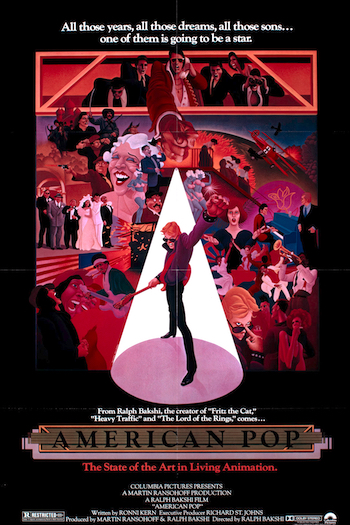 Though it’s neither as schmaltzy or as jokey, it reminds me a little bit of FORREST GUMP in the way it tries to tie together decades of American history through, in this case, four fathers. But the filmmaking reminds me more of Martin Scorsese, in illustrated form. And occasional live action bits. The way Bakshi and editor David Ramirez (NEW YORK, NEW YORK) rhythmically, expertly cut in flashes of historical footage here and there for context reminded me of Spike Lee. Like DA 5 BLOODS, Bakshi shows that infamous Hong Kong execution photo in motion, but he makes the possibly even more shocking choice of re-creating it in caricature.
Though it’s neither as schmaltzy or as jokey, it reminds me a little bit of FORREST GUMP in the way it tries to tie together decades of American history through, in this case, four fathers. But the filmmaking reminds me more of Martin Scorsese, in illustrated form. And occasional live action bits. The way Bakshi and editor David Ramirez (NEW YORK, NEW YORK) rhythmically, expertly cut in flashes of historical footage here and there for context reminded me of Spike Lee. Like DA 5 BLOODS, Bakshi shows that infamous Hong Kong execution photo in motion, but he makes the possibly even more shocking choice of re-creating it in caricature.
I think there’s also something Lee-esque about the wall-to-wall music, sometimes in original recordings, sometimes adapted and woven into a grand score by Lee Holdridge (JONATHAN LIVINGSTON SEAGULL, THE BEASTMASTER). You get everything from Scott Joplin to Cole Porter to Herbie Hancock, Art Blakey, Sam Cooke, the Mamas and the Papas, The Doors, Jimi Hendrix, Pat Benatar and Lynyrd Skynyrd. According to the book Unfiltered: The Complete Ralph Bakshi by Jon M. Gibson & Chris McDonnell, Bakshi brought it to Columbia Pictures because their president Dan Melnick “knew the power of music like few in Hollywood did,” having been behind THAT’S ENTERTAINMENT! and ALL THAT JAZZ.
Something you may or may not know about Bakshi that’s relevant to our discussion here is that he was a major practician of rotoscoping – the technique of tracing animation over live action footage. It’s an old method, patented by Max Fleischer, used in his Out of the Inkwell shorts and even adopted by Disney for certain parts of SNOW WHITE AND THE SEVEN DWARFS. It takes away the exaggeration that animation excels at, but it’s good for capturing complex, realistic movements or shifts in perspective, which is why they used it to get Snow White’s dancing right.
Bakshi stumbled into being the rotoscope guy when he ran out of money for the battle sequences on WIZARDS and figured out a cheap way to print frames of ALEXANDER NEVSKY with an industrial photocopier. When he later did THE LORD OF THE RINGS, he shot the majority of the movie in live action and traced over it, an approach he carried into AMERICAN POP and FIRE AND ICE.
That was controversial. Rotoscoping has been derided as a cheap short cut to “real” animation, including by myself when I was younger. It definitely has a different feel than seeing animated characters and movements that spring more fully from the imagination, but I appreciate it now. In a way it predicted the manner in which many films are made today; Bakshi didn’t need a green screen or a jumpsuit covered in dots, but he was able to shoot actors with chintzy props somewhere and create a whole world around them in post. (He even has the same actor playing two different main characters, like Tom Hanks in THE POLAR EXPRESS or Gary Oldman in A CHRISTMAS CAROL.) The resulting footage captures details of human movement and expression more closely than traditional animation, but it’s not an attempt to be photorealistic. There is still simplification and stylization, especially in the colors and backgrounds. It’s a mutant hybrid of live action and painting, and it works well for this story.
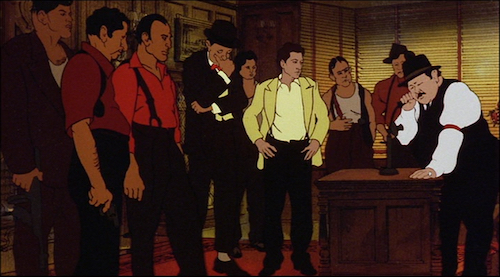
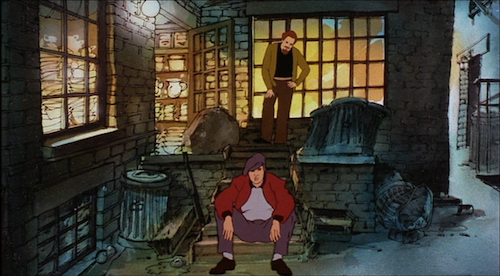
You could never mistake a Bakshi movie for somebody else’s, not just because of the style, but because he puts his personality and life experiences into them. This one has the immigrant family, the rough New York neighborhood, the gangs, the Judaism, the horniness, the love of music. And one thing I think of as unique to him as far as animation goes is the raw, improvised-sounding dialogue. In this case it’s combined with very specifically observed expressions, postures and tics that I think represent a naturalistic style of acting I don’t think I’ve ever seen in animation before. I don’t think I ever knew it was possible in animation. It can be showy at times, but also it can feel very real and gritty and just crazy to see in drawings.
Because of the scope of the story some broad strokes are required. You’re covering four lives and eras in an hour and a half, but each of them gets some great, affecting scenes. Young clown Zalmie (Jeffrey Lippa, location assistant, DEAD HEAT) becomes smitten with a stripper after seeing her putting her clothes on. When he gets up the nerve to approach her she has just returned from the stage and dressed, and then undresses again for him – as he takes off his clown costume. Romantic. A war injury ends his dream of singing, so he ends up involved in the mob (there’s a whole gang war montage set to “Sweet Georgia Brown”) and doesn’t understand when his son Benny (Richard Singer, later a producer and writer for Suddenly Susan) just wants to play jazz piano.
I really like how one instrument ties together three of the generations. Benny enlists in WWII and finds himself sitting around playing “As Time Goes By” on harmonica. His buddies don’t know he’s a musician and think he sucks at it. In maybe the movie’s most moving scene he discovers a piano in a bombed out building and sits down to play it. A dying Nazi soldier climbs out of the wreckage behind him and slowly, shakily tries to aim at him. Rather than run, Benny switches to playing the German love song “Lili Marleen.” The Nazi stops to listen, even smiles and thanks him, but kills him anyway. An intimate moment where two doomed enemies, one evil, the other trying to redeem his family, briefly connect through the beauty of music.
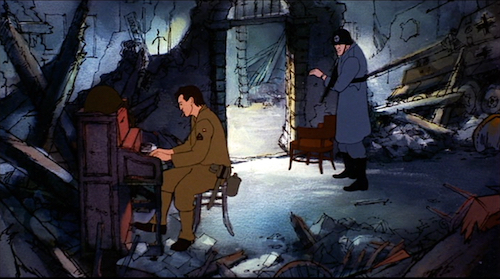
Benny’s son Tony (Ron Thompson, “Frozen Dog Pimp,” THE WHITE BUFFALO) inherits the harmonica, and learns to play it from a hobo he meets while riding the rails. And when he’s old and washed up he gives it to his son Little Pete (Eric Taslitz, Galactica 1980, LAMBADA). When Pete tries it out he plays “As Time Goes By.”
Tony’s story gets the most screen time. He goes to a beatnik club and is impressed by a poet (Richard Moll, HOUSE) but his dumbass mafioso buddies don’t get it so he ditches New York City to drive across the country, ends up washing dishes in Kansas, making a weird monologue about corn to a waitress he falls in love with for a day (July 1982 Playmate of the Month Lynda Wiesmeier, AVENGING ANGEL, REAL GENIUS, TEEN WOLF). She seems to think it’s cute but is not up for the adventure of riding the rails to California with him. In San Francisco some hippie dudes on a porch hear him playing “California Dreamin’” on his harmonica, invite him in, he ends up becoming a very successful songwriter for their singer Frankie Hart (Marya Small, ONE FLEW OVER THE CUCKOO’S NEST, PUPPET MASTER), who’s a total mess and also, I thought, pretty charismatic. And they fall in and out of love and have fights and, because it’s a rock ’n roll movie, shoot up and wreck their lives.
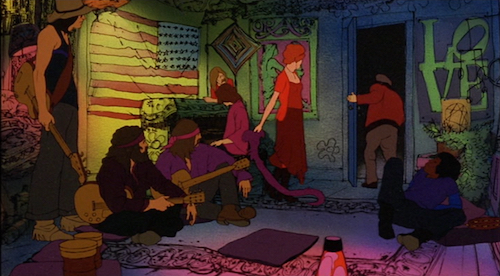
Now, let’s jump ahead in time for a second here. AMERICAN POP was apparently considered a successful movie upon release. One reason that was possible is that it was made in a window when the licensing of songs for soundtracks was not as expensive as it would soon become, and with his hip reputation Bakshi was able to secure all these huge songs and artists for under a million. But there was a catch: this was right before home video caught on, so they didn’t think ahead to include that in the deal. As a result, the movie remained unreleased on video until 1998. The year BLADE came out! That’s a long time.
But I was into those Bakshi movies so I’d read about it and wanted to see it for years and one day I was flipping through channels and came across this weird rotoscoped thing and holy shit, this must be AMERICAN POP! A miracle. But I realized right away there were two things about the movie that were hard for me to swallow, and it’s time to explain those now.
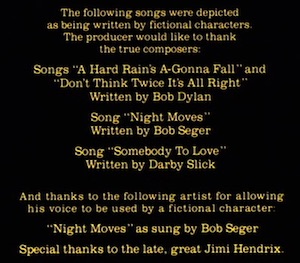 Number one is this conceit that it’s painting (or, uh, tracing) a portrait of particular periods of America, using real historic events and era appropriate music, but when we get to Tony in the ‘60s we have to accept that he’s writing, and his friends are performing, famous songs by artists we are familiar with. Frankie is clearly an amalgamation of Grace Slick and Janis Joplin, and one of her big scenes is an achingly beautiful rendition of “Summertime.” The actual recording by Joplin.
Number one is this conceit that it’s painting (or, uh, tracing) a portrait of particular periods of America, using real historic events and era appropriate music, but when we get to Tony in the ‘60s we have to accept that he’s writing, and his friends are performing, famous songs by artists we are familiar with. Frankie is clearly an amalgamation of Grace Slick and Janis Joplin, and one of her big scenes is an achingly beautiful rendition of “Summertime.” The actual recording by Joplin.
Later, grown up Pete (also played by Thompson) is a coke dealer for many successful musicians, and using their dependance on his wares as leverage he convinces some hotshots in a studio to listen to a song he wrote… which turns out to be fucking “Night Moves” by Bob Seger. Again, the actual Bob Seger recording, coming out of his mouth.
 And that brings me to the second problem I had, which is the entire character of Pete. When he first wanders into the movie, a local Kansas kid randomly hanging out backstage with Frankie while the band waits for Hendrix to get off stage, his Don-Bluthian blond-haired-blue-eyed moppetness is comically over-the-top. It clashes with the realism of the movie, but I forgave it because of how it wordlessly conveys Tony’s recognition that this kid has to be the result of his one-night-stand with the beautiful blonde waitress in corny Kansas.
And that brings me to the second problem I had, which is the entire character of Pete. When he first wanders into the movie, a local Kansas kid randomly hanging out backstage with Frankie while the band waits for Hendrix to get off stage, his Don-Bluthian blond-haired-blue-eyed moppetness is comically over-the-top. It clashes with the realism of the movie, but I forgave it because of how it wordlessly conveys Tony’s recognition that this kid has to be the result of his one-night-stand with the beautiful blonde waitress in corny Kansas.
But then they start drawing the kid with sunglasses and slicked-back hair and dressing like a rock star – like a precursor to Macaulay Culkin in the rap part of the “Black or White” video.
When he grows up he becomes even more ludicrous. Representing the cutting edge of the late ’70s and early ‘80s, he struts around doing Elvis moves as he sells coke in the punk rock scene (I guess that’s Lee Ving and Fear pretending to play “Pretty Vacant”?) and talks in some kind of misjudged caricature of a cocky greaser guy. Except with purple lenses and jacket. Nic Cage might’ve studied those moves, but the voice is more like somebody doing a terrible Vinnie Barbarino. And then after “Night Moves” makes him a giant rock star he performs “Blue Suede Shoes”?
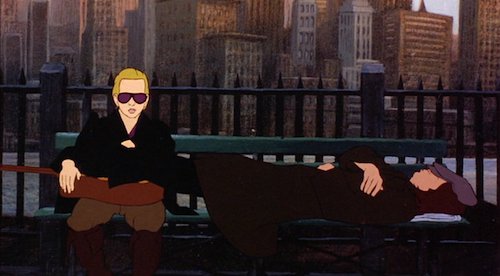
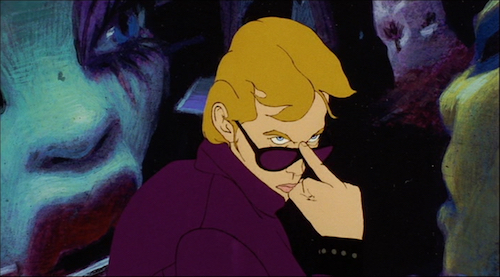
Many of Bakshi’s movies deal with race, most controversially in his Blaxploitation version of SONG OF THE SOUTH, COONSKIN (later retitled STREET FIGHT on video, for obvious reasons). AMERICAN POP avoids the topic, but it’s always there because Bakshi is smitten with Black culture and music, as is America in even the most racist of times. Almost all of this music is being created by Black artists and then popularized by white ones. Benny is the leader in an otherwise all Black jazz band. Tony impresses the band by playing what he learned from Black musicians on the train. Frankie is singing her white girl version of the blues (well, Janis Joplin’s). And here at the climax is Pete doing Elvis doing what he learned in part from Black musicians in churches and on Beale Street.
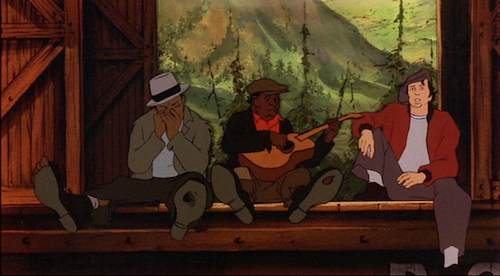
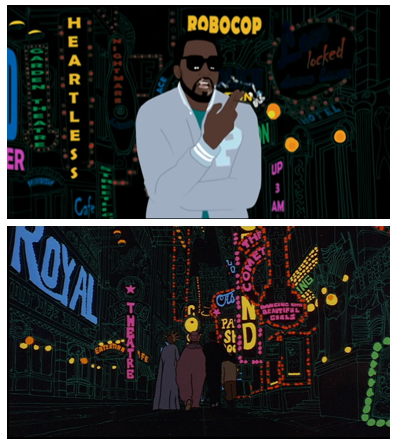 Related: The rotoscoping is really good for capturing not only live action camera moves and perspectives, but the beauty of dancing. But is it cheating to animate over footage of the Nicholas brothers in STORMY WEATHER? Is it stealing their moves in the most literal way possible? Did they get paid for it?
Related: The rotoscoping is really good for capturing not only live action camera moves and perspectives, but the beauty of dancing. But is it cheating to animate over footage of the Nicholas brothers in STORMY WEATHER? Is it stealing their moves in the most literal way possible? Did they get paid for it?
(In fairness, the movie also uses footage from THE PUBLIC ENEMY for some ballroom dancing and tommy gun shootings and HELL IS FOR HEROES for airplane battles. When you’re stretching a budget you gotta take shortcuts.)
Anyway, this is Ralph Bakshi’s perspective of music, so it works. It would be cool to see another movie like this from a Black perspective. (Not the same thing, but Hype Williams’ video for Kanye West’s “Heartless” was inspired by AMERICAN POP, and very directly homages one of its settings.)
So what does it all add up to? With all its time passage and tragedy there’s the feeling of a musician biopic, but deifying some dude doesn’t seem like Bakshi’s thing. He’s into the sad poetry of scummy street dudes. Zalmie lives his dream of “singing” by ratting out the mob. Bennie gets shot in the middle of nowhere. Tony has success as a songwriter but ruins his life and is last seen slipping on a park bench. But according to the poster, “All those years, all those dreams, all those sons… one of them is going to be a star.” And Pete is at the center, in a spotlight, doing one of his jackass Pete type poses, so it seems it’s about how these decades of dreaming and struggling in an immigrant family are leading to the destiny of… a blonde Kansas boy who grows up on the streets, but uses his coke-dealing connections to become a superstar repackaging a ’50s idea of cool?
Yeah, that actually seems pretty right for 1981.
Any misgivings I have – the corny-ass Pete stuff at the end is definitely the biggest one – don’t bother me much anymore because this movie is so unusual and ambitious, and so good in many ways. There are so many great little moments in the middle of this sprawling story. Like the exactness with which the animators depict kids watching TV and trying to ignore Tony’s beatnik monologue deriding them:
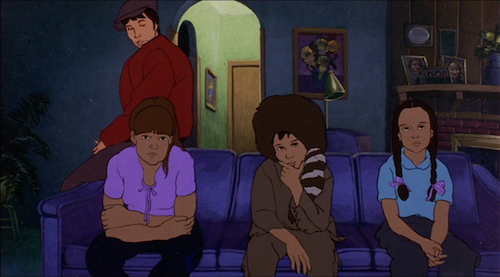
Or the way we can see the unnamed waitresses’ attraction to him in her nervous shuffling and smile as she listens to his ramblings, or the way she narrows her eyes smiling at his jokes.
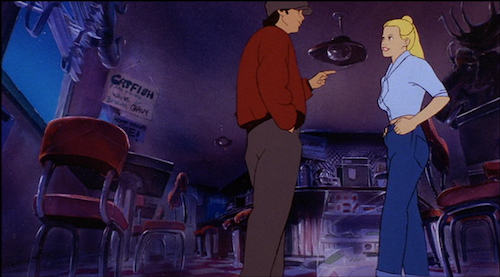
Or the scene where Tony is a flaming mess of grief as paramedics carry out Frankie’s dead body, but he runs over and tucks her arm and face under the sheet to protect her dignity. The performance is melodramatic, but that part got me. I believe something like that happened in AN EXTREMELY GOOFY MOVIE, but otherwise you don’t really see that in animation.
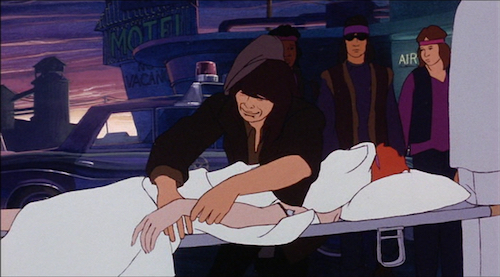
I love the more-detailed-than-most-animation drawings in front of backgrounds that are allowed to be more painterly and varied than in animation from the big studios. They are phenomenal drawings and paintings but then sometimes they’ll just be white linework on black or switch to loose oil pastels or something.
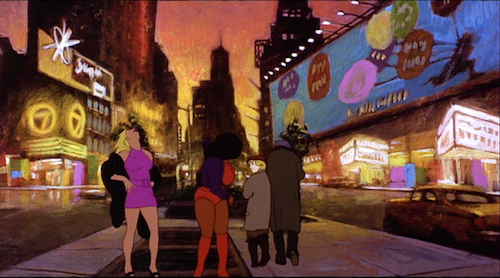
It gets more colorful from the hippie era on. And at the end there’s like a big laser show. I like that you kinda get glimpses of the live action reference for Pete, except optical printed in various colors.
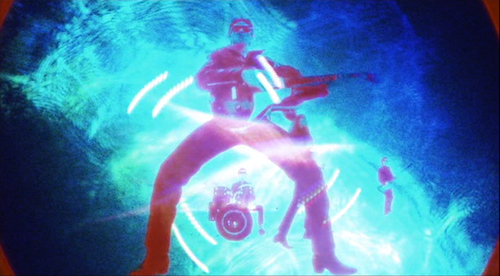
I assume there must be an HD transfer of AMERICAN POP, because it’s available digitally (I rented the DVD). I don’t know if the music is too expensive now or what, but it is worthy of a nice Blu-Ray release, if for no other reason than to erase the memory of the horrible DVD cover, which has Pete standing on top of a giant DVD, to show off that it was finally available on DVD. Way to think ahead there, marketing department.
(August 2023 update: a blu-ray just came out!)
Like most of Bakshi’s movies, this is messy, and it’s personal, and it’s special. I’m not sure he ever managed to get everything right on a movie, but he takes swings nobody else does and often makes contact, so they’re always gonna be interesting. I respect that a guy could start out drawing Heckle and Jeckle, and work his way up the totem pole in an artform as complicated and commercial as animated features, but still see himself as an underground filmmaker. In Unfiltered, Bakshi says, “The underground films started softening up in the ‘80s because the bigshots took over. Everyone’s playing the game. Maybe it’s gotten so big, you’re powerless. There is no more underground. POP was the last time Iet it all hang out in a feature.” (He still managed to do HEY GOOD LOOKIN’, FIRE AND ICE and COOL WORLD, and got in trouble for making Mighty Mouse snort a flower.)


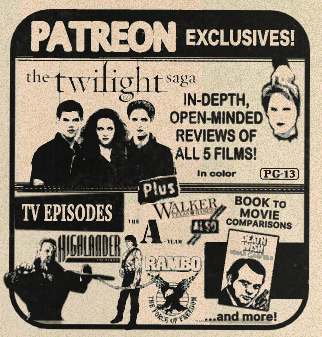
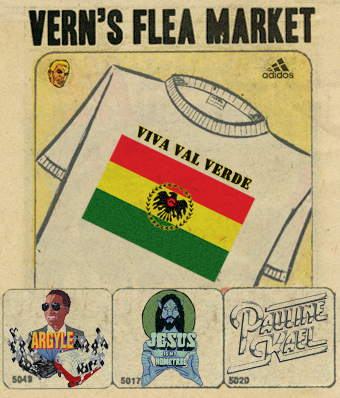
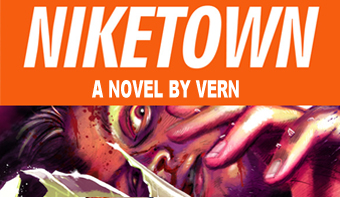
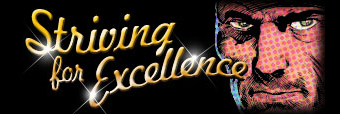
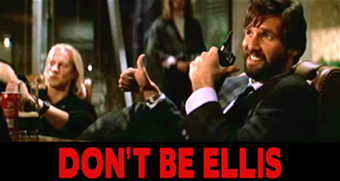
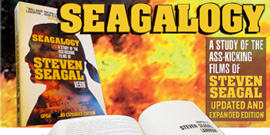
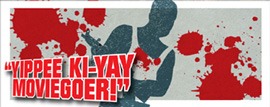








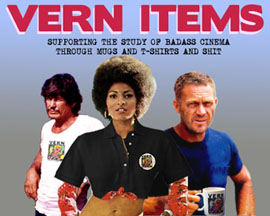
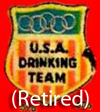
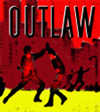







March 1st, 2021 at 1:58 pm
I have tolerated some questionable views from our host over the years, but I’m afraid this unchecked hostility toward American treasure Bob Seger may be a bridge too far. How dare you, sir. HOW DARE YOU.
I celebrate the shaggy auteur’s entire catalogue, from his early psychedelic boogie-woogie blues with The Bob Seger System to his classic meat-and-potatoes songwriting with The Silver Bullet Band to weird solo joints like “Shakedown” from BEVERLY HILLS COP II (better than Glenn Frey’s “The Heat Is On” from the first one. Yeah, I said it.) and even a few tracks on his recent comeback album, despite a lot of it sounding like Trey Parker doing a Bob Seger parody. But I’ll just drop this righteous little anthem right here, which got me through many soul-draining subway commutes back in the day. (Also if you think of “number” as beatnik slang then it’s a double entendre about wanting to get high, which was also extremely appropriate for those commutes.)
I pray you learn the error of your ways, Vern. You beautiful loser you.
Feel Like A Number-Bob Seger
From Bob Seger and the Silver Bullet Band's 1978 album, "Stranger in Town"